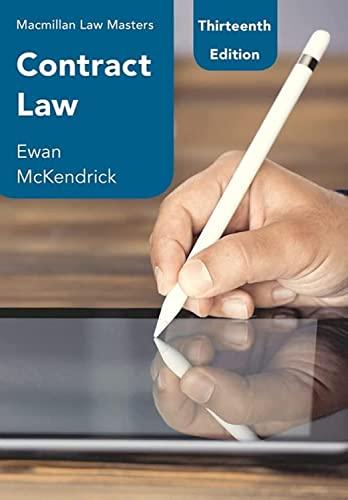Question
Rule of Physical Force (Anarchy) -The source of property rights is coercion by physical force. Access to property is restricted to those with the physical
Rule of Physical Force (Anarchy) -The source of property rights is coercion by physical force. Access to property is restricted to those with the physical ability to take and defend it -Property rights are enforced by vigilance or personal policing which uses resources that could be used in other ways. (there is no effective enforcement by the state) -Peaceful transfer of property rights is difficult and uncommon. It is limited by disorder, by lack of a consistent enforcement, and by the absence of formal and recognized proof of ownership -The resulting uncertainty and instability surrounding ownership of assets means that property is relatively useless as collateral for taking on debt Rule of Men -The rule of men is the "ability of government officials to govern by their personal whim or desire" -Formal law may exist, but the elite determines if when, and how it is applied -Decisions are frequently arbitrary, tinged with political favoritism -The source of power to grant and enforce property rights lies in inherited positions, usually backed by political connections and military might -Enforcement is frequently arbitrary and lacks consistency -Transfer of assets and/or property rights is restricted by the need to obtain permission from those "in charge" -Because ownership continues only at the whim of the elite, assets are of little use as collateral Rule of Law -The National Standards for Civics and Government define the rule of law as "an essential component of limited government. The central notion of a rule of law is that society is governed according to widely known and accepted rules followed not only by the governed but also by those in authority". -The rule of law...establishes limits on both those who govern and the governed, making possible a system of ordered liberty which protects the basic rights of citizens and promotes the common good. This basic notion of the rule of law has been accompanied by the ideal of equal protection of the law... the standards go on to specify the benefits of the rule of law: it establishes limits on both those who govern and the governed it makes possible a system of ordered liberty that protects the basic rights of citizens it promotes the common good -Nations in which the rule of law prevails share the following characteristics: there is (usually written) constitution there is a written body of law that applies to all government officials are not exempt from the law government powers is limited by a system of checks and balances there is an independent (non-partisan) judicial branch which makes decisions based on written law and or precedent the court system guarantees the provision of due process before life, liberty or property is taken FILL CHART BELOW

Step by Step Solution
There are 3 Steps involved in it
Step: 1

Get Instant Access to Expert-Tailored Solutions
See step-by-step solutions with expert insights and AI powered tools for academic success
Step: 2

Step: 3

Ace Your Homework with AI
Get the answers you need in no time with our AI-driven, step-by-step assistance
Get Started


